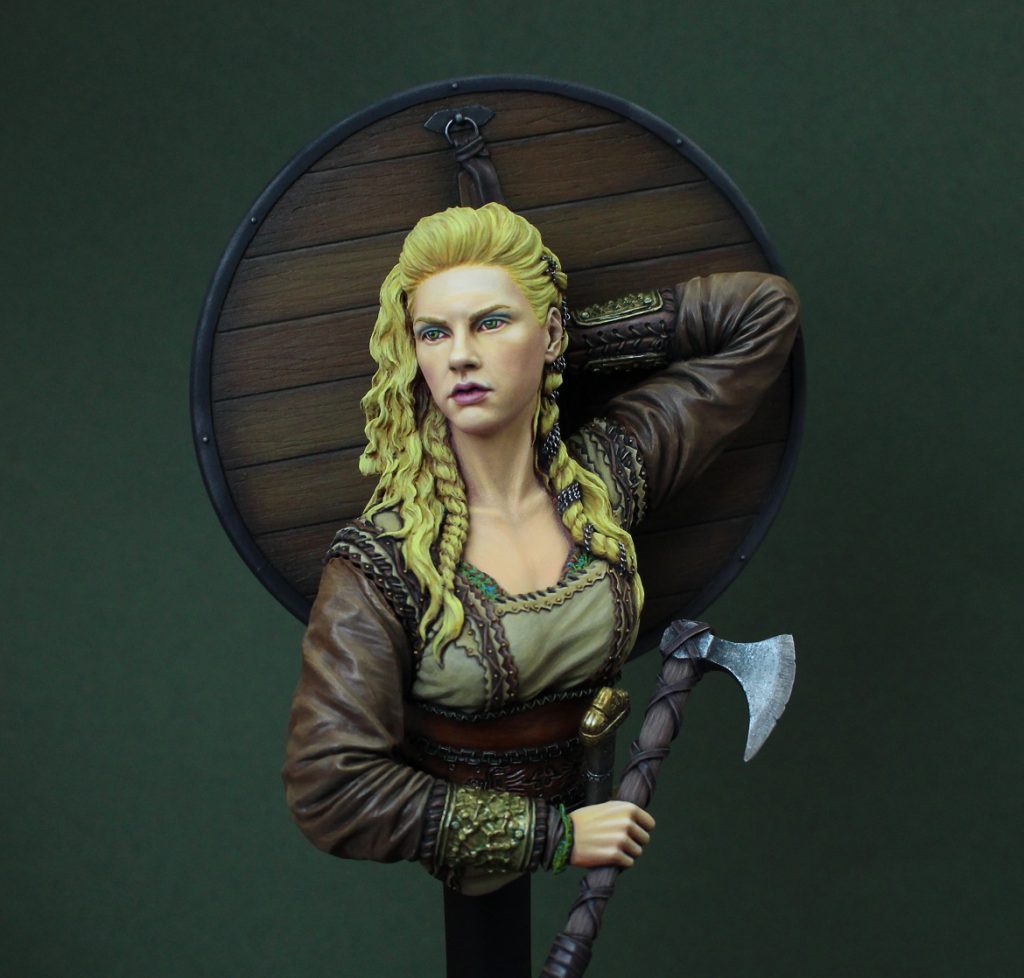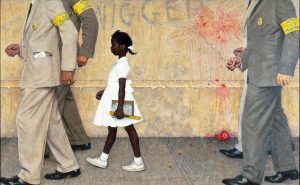Fierce Viking Age warriors rampaged, warred, and plundered throughout northern Europe and the northern Atlantic from the ninth until the eleventh century. Until recently most scholars assumed Viking military forces were entirely male. However, this is an inaccurate over-generalization as new evidence suggests that female warriors were included on the battlefield. Twenty-first century archaeological technology and DNA testing expanded available information to provide crucial missing pieces to the fabric of history. Vikings recognized women who fought and died beside their brothers-in-arms.
During the Viking Age, Scandinavia was not one politically cohesive area but its people did share religious beliefs, domestic lifestyle, trade, and warfare tactics. Viking life was harsh compared to other societies at the time. There is no evidence of large-scale sophisticated cities. Instead the region’s people settled into relatively isolated farming communities and trading posts, as the geography allowed.1 These conditions made land a valuable commodity, and, at times, men and women raided beyond their homelands to obtain it. Long winters and arduous terrain limited the Vikings’ agricultural cultivation opportunities. If a community was to thrive, every able-bodied person would have been required to work what fertile farmland could be found.
Possibly due to this dynamic, Viking women held higher social and legal statuses compared to women in many simultaneous societies worldwide. Women could initiate divorce and independently own property.2 Instead of a simple divide between male and female genders, “the fault line runs between the able-bodied men and exceptional women on one hand and, on the other, a kind of rainbow coalition of everyone else (most women, children, slaves, and old, disabled, or otherwise disenfranchised men).”3 Capable women received equal treatment to that of men, which could have included training with weapons and in battlefield tactics. These skills would have been valuable in raids, which were a common Viking practice. In fact, a Viking’s personal wealth was generally amassed through foreign raids, which were organized by private individuals who could afford to do so. Thus, displays of foreign-acquired wealth were the primary status symbols in Viking society.

One such status symbol, a large, natural stone was acquired by a Viking woman who later commissioned it as a runestone grave marker for her husband.4 The stone was erected in the farmlands of Alstad, Norway with the inscription “Jorunn raised this stone after…, who had her to wife and [she] brought [it, i.e. the stone] from Ringerike, out of Ulvoya. And the stone shall honor them both.”5 Ulvoya is an island located over one hundred kilometers Southwest of Alstad. The logistics required to traffic a large stone over the water and over a large distance of mountainous land suggests that the stone was a prized acquisition, possibly a conquest trophy. Runestone grave markers were not a common practice in Viking Era Norway, and only thirty-eight runestones are archived within its modern borders.6 The female commissioner of the Alstad Stone made a point to commemorate how she obtained and transported the stone from elsewhere. The stone’s acquisition, and the owner’s financial ability to commission the uncommon memorial, indicates that she was a wealthy woman. With this runestone, the widow Jurunn simultaneously honored both her husband’s memory and her own conquests.
In addition to transportable wealth, Viking warriors claimed land as spoils of war. The Vikings established modern-day Iceland’s first colonies. However, the Vikings who colonized the island could not have known the land mass was unsettled, and they must have been prepared to suppress a local population by military force. Written records indicate that the first colony in Iceland had four hundred original land claimants, thirteen of whom were women. This number does not include women who were listed under their husbands’ or brothers’ names on land claims. These thirteen women were listed independently from any man.7 This fact indicates that there were women included on this voyage who were prepared to fight side by side with the men and that these women took their share of the plunder in land claims.

Further evidence of female warriors was discovered in Repton, England. The Anglo-Saxon Chronicles record that a great Viking army occupied the parish Repton in 873-74 A.D. and assumed complete authority over the land. A 1980s Repton excavation of the church discovered a mass burial mound that contained bones of at least 264 Vikings. Close examinations of left femur and mandible sizes compared with approximate biological age demonstrate up to twenty percent of remains were female. The mass graves contained Viking burial goods, and the skeletal remains frequently show signs of violent injuries.8 It is reasonable to conclude these men and women fought and died together. Bodies of Viking warriors slain in battle were afforded the honor of burial even on foreign soil. “The bodies of their own dead, which must be left behind, the Scandinavians carefully buried upon the field of battle; but they displayed their scorn and contempt for the vanquished enemy by leaving the dead comrades of the latter unburied where they fell”.9 These Viking burial rights on foreign soil preserved the battlefield aftermath and provide additional historical context into who fought and died.
The Rempton excavation analyzed Viking remains utilizing multiple twenty-first century technologies. Prior to these developments scholars generally determined gender based on grave goods. If an individual was buried with weapons or agricultural equipment, the remains were male. Conversely, if an individual was buried alongside domestic objects, such as keys or jewelry metal brooches, scientists believed the grave held female remains.10 However, more recent excavations revealed the capability for a woman to be buried with military weapons.
The most prominent example to date comes from the coastal trading post of modern day Birka, Sweden which upended the very core of academic Viking Era knowledge. There are 3,000 graves in proximity to Birka, over 1,100 have been excavated to various degrees; but one grave, designated Bj 581, held the power and evidence to solidify what was previously only speculation and educated guesswork.11 “The grave goods include a sword, an axe, a spear, armour-piercing arrows, a battle knife, two shields, and two horses, one mare and one stallion; thus, the complete equipment of a professional warrior.”12

DNA samples were extracted from a canine and femur bone of Bj 581’s human remains and processed at the Archaeological Research Laboratory, Stockholm University. Genome-wide sequence data was produced to provide better insight into who was buried. Mitochondrial DNA was isolated, and the results of sex chromosomes analysis concluded “…that Bj 581 was a female”.13 Additionally, analysis performed on extracted molars were compared against other Birka graves attributed to the same time period and tested for possible geographical origins. “The strontium isotope values in three teeth could suggest mobility in her early years. The Sr ratio falls outside of the local baseline for the established Birka population, suggesting that this individual moved there later in life.”14
Bj 581’s test results have cultural and historical implications of a far-traveled Viking era woman buried with traditional warrior grave goods. Multiple weapons included with the rare presence of horses is generally agreed as indicative to a high-ranked warrior. Twenty-first century research has confirmed this military grave belonged to a woman, it is necessary to rethink what is Viking Age common knowledge and the period’s gender roles.15 There is now genetic proof of at least one Viking Age woman warrior buried with high military distinction. Bj 581’s existence adds to the probability that other Viking Age women were participated directly in combat.
The two hundred year Viking Age was a unique period in history. An individual’s worth and status were determined by contribution and ability, not solely predetermined by biological gender. For the warlike Vikings, if a woman had the ability and inclination to bare a sword and fight alongside men, she may have been afforded the opportunity to do so. The Viking woman warrior has carved her place in history, and our historical perspectives must be adjusted to correctly include women into what constitutes a Viking warrior. These brave women earned a place within their society and our military history, and we need to recognize what it was.
- Mary Williams, Social Scandinavia in the Viking Age (New York: The Macmillan Company, 1920), 243. ↵
- Ross Samson, Social Approaches to Viking Studies (Glasgow: Cruithne Press, 1991), 66,70. ↵
- Carol Clover, “Regardless of Sex: Men, Women, and Power in Early Northern Europe,” Speculum 68, no. 2 (1993): 363-87, accessed June 1, 2019, https://doi.org/10.2307/2864557. ↵
- Alstad Stone, Museum of Cultural History, no. 61, Oslo, Norway. ↵
- Judith Jesch, Women in the Viking Age (Woodbridge: The Boydell Press, 1991), 70-71. ↵
- Judith Jesch, Women in the Viking Age (Woodbridge: The Boydell Press, 1991), 70. ↵
- Judith Jesch, Women in the Viking Age (Woodbridge: The Boydell Press, 1991), 81-82. ↵
- James Graham-Campbell et al., Vikings and the Danelaw (Oxbow Books, 2016), 45. ↵
- Mary Williams, Social Scandinavia in the Viking Age (New York: The Macmillan Company, 1920), 268. ↵
- Judith Jesch, Women in the Viking Age (Woodbridge: The Boydell Press, 1991), 13. ↵
- Nils Ringstedt, “The Birka Chamber-Graves- Economic and Social Aspects,” Current Swedish Archaeology 5, no. 20 (1997): 127. ↵
- Charlotte Hedenstierna-Jonson et al., “A Female Viking Warrior Confirmed by Genomics,” American Journal of Physical Anthropology 164, no. 4 (2017): 854. ↵
- Pontus Skoglund, Jan Stora, Anders Gotherstrom, & Mattias Jakobsson, “Accurate Sex Identification of Ancient Human Remains Using DNA Shotgun Sequencing,” Journal of Archaeological Science 40, no. 12 (2013): 4477-82. ↵
- Charlotte Hedenstierna-Jonson et al., “A Female Viking Warrior Confirmed by Genomics,” American Journal of Physical Anthropology 164, no. 4 (2017): 857. ↵
- Pontus Skoglund, Jan Stora, Anders Gotherstrom, & Mattias Jakobsson, “Accurate Sex Identification of Ancient Human Remains Using DNA Shotgun Sequencing,” Journal of Archaeological Science 40, no. 12 (2013): 4477-82. ↵



56 comments
Steven Clinton
Very interesting article! Who would of known woman played a prominent role in the Viking Society. People tend to think of barbaric men when they think of Vikings, now they have to consider barbaric woman! Its crazy how far modern day archaeology has evolved. These archaeologist have the capabilities to learn so much from the aged relics and fossils they find.
Annissa Noblejas
Much of what the world knows about Vikings comes from Christian accounts. To those scholars the Vikings represented wrath and destruction but there is so much more to learn beyond those accounts.
Charli Delmonico
This article was incredibly interesting! I guess I never realized that whenever I pictured vikings, I originally never thought of women being in the mix. I’m glad that the vikings didn’t discriminate solely based on gender. They were able to see the value of strong women and to recognize their abilities as being equal to those of the men. I also think it is really cool that strong women were able to own their own land and truly dictate their own lives without any supervision from a man.
Greyson Addicott
The Vikings were truly something else—who would have guessed that a culture we so often dismiss today as overtly barbaric could have been so progressive in their way of life? Overall, the article was an awesome read, and the research regarding genomic data and historical events that really shines throughout it only added to its informative nature!
Audrey Uribe
What a very powerful article! Very interesting evidence of female warriors and how the agriculture of the land would prove that everyone in their community must have contributed. You would think that from the trajectory of our country’s history with gender equality that other prior civilizations would have worse gender equality limitations but I was shocked to read that a women could instigate divorce and even own property which wasn’t a thing in America till the 19th century and even then a women could not control property without spouse. Exciting evidence of in DNA of the double X sex chromosome that proved women could have held high positions of power.
Jacob Silva
This article in particular was rather interesting and gave me insight into the vikings that I didn’t have previously. I had always assumed that the vikings were more of a male dominated society, however new evidence has denied this assumption. Now it is understood that women stood on equal footing as the men and even played a role in the Viking military.
Jose Chaman
This article is very interesting. I never knew that the Vikings gave so importance to the females, in those times was really hard to find a society where the woman had a principal role and actively participation in the community decisions. The history of the Vikings shows us that in a society where we all treat each other equally is the key to progress. I totally agree with the last sentence of this article: we need to recognize the important contribution that not only Viking females but females as a whole gave to our society to be what it is now.
Amelia Hew
The Vikings are truly a mysterious and unique race. I always thought that females of their race were looked down upon like any other females throughout the history, but apparently women were treated as equal as the man and can even initiate divorce and own independent property which is not very common in that era. It is also fascinating to learn about that Viking women participates in conquests and those who had fallen even had their names listed independently from any man which makes the Viking cultures even more intriguing to learn about.
Malleigh Ebel
This article was very interesting and inspiring for me to read! The new, solid evidence of there being Viking women in positions of power. This evidence was found in the DNA (the double X sex Chromosomes) of buried Vikings which were not previously considered to be possibly women. It’s becoming more apparent to historians that able bodied women were respected as equals to men, which is interesting since after the Neolithic period (and with the rise of city-states) most societies became patriarchal.
Sebastian Azcui
I really liked this article and the topic is very interesting. I do not know much about Vikings but with this article I learned more about them and how their society was formed. Something that impressed me is how women could fight next to men and go to war. Woman had rights and power in viking society and were respected. For this period of time it is very weird to hear that woman had this kind of power and respect.
Kristina Tijerina
It’s always been that men and women were not seen as equals. It was always men doing the difficult work and women providing at the house. Men were always seen as more brave and strong, which is why there have been many male rulers. This article was very interesting to read because of the role that women played in the viking military. Many people thought that only men were fighting in the wars, but new studies, advances in archaeological technology, and DNA testing proved otherwise. With twenty-first century technology, people were able to extract DNA samples from canine and femur bones, and isolate the mitochondrial DNA to find out if the remains belonged to a male or female. DNA testing along with whatever possessions these individuals died with led to the discovery that women played a fighting role in the viking military.